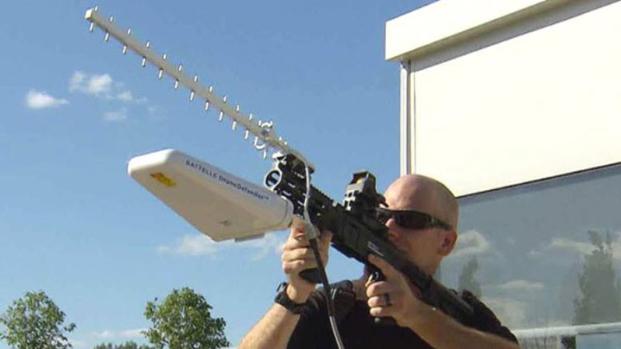The company that made headlines when it introduced a military anti-drone weapon late last year is hard at work on a more compact, capable version that will be even more useful on the battlefield.
The DroneDefender, by research company Battelle, is designed to be carried and aimed much like a rifle. The 15-pound device works by interrupting the frequencies that enemy unmanned aerial systems operate on to bring the UAS down and neutralize the threat.
It found immediate demand. The Department of Homeland Security and the Defense Department together ordered 100 DroneDefenders earlier this year, and the device has been spotted in use by the Army in Iraq. Since then, said Dan Stamm, manager of counter-UAS programs for Battelle, the military has ordered more of the systems, though he can't disclose how many.
"The system that we generated was in proactive response to a need that we saw coming," Stamm told Military.com in an interview. "Understanding the potential threat that was out there, we generated the version one [DroneDefender] on our own. When the realization started occurring that this was indeed going to be a threat, our solution may not have answered all the challenges, but it answered a vast majority of them. Now, we're spending our own investment to close up additional challenges and threats that may be received by our users."
This second iteration of the DroneDefender will be significantly reduced in weight and size, Stamm said, and more streamlined and efficient in power consumption. Researchers are also looking at expanding the range of frequencies that the device can disrupt to pull drones out of the sky.
Stamm said the company was roughly three months away from a functional second-generation prototype, but there are many unknowns remaining. It's not clear how much smaller and lighter the device will get, and while it will probably stay in a rifle configuration for now, Stamm's team is looking at ways to make it more compact or self-contained.
While some troops have asked if the DroneDefender could become a device that attaches to a soldier or Marine's service rifle for maximum ease of use and portability, Stamm said that doesn't seem realistic in the near-term because of the technology involved. Shrinking the technology used to disrupt frequencies to that extent could make the system more vulnerable to small shifts and adjustments by an adversary drone operator, he said. If the company took a different tack and made a device that instead took UAS down via cyber-attack, that might allow for a smaller system, he said, but it would also make the system ineffective in the face of even simple encryption.
"We are getting into this laws of physics kind of situation," he said. "While our system is very robust, it is to some extent limited."
And while the system has received attention from civilian law enforcement and firefighting agencies who contend with the growing nuisance of commercially available UAS that can thwart or disrupt their work, Stamm said the system remains only available to military buyers as disruption of the federally regulated communications spectrum remains illegal.
The company is branching out in other ways, however; Stamm said Battelle has received some orders for the DroneDefender from international buyers this year.









